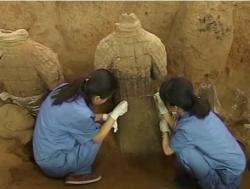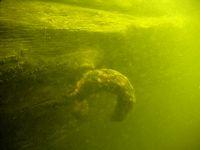INSTITUT SUPERIEUR D'ANTHROPOLOGIE
INSTITUTE OF ANTHROPOLOGY
ONLINE COURSES / COURS A DISTANCE
INSCRIPTION 2012 / Session III : Juillet 2012
REGISTRATION 2012 / Term III : July 2012
CHINE –  Qin Shihuang - Archaeologists unveil 120 new terracotta warriors at the Qin Shihuang Unesco World Heritage site in Shaanxi province, China. The latest discoveries include never-before-seen artefacts, such as war drums and a painted shield. The current excavation started in 2009, following the first two in 1974 and 1985.
Qin Shihuang - Archaeologists unveil 120 new terracotta warriors at the Qin Shihuang Unesco World Heritage site in Shaanxi province, China. The latest discoveries include never-before-seen artefacts, such as war drums and a painted shield. The current excavation started in 2009, following the first two in 1974 and 1985.
VIDEO = http://www.guardian.co.uk/world/video/2012/jun/09/terracotta-warriors-unveiled-china-video
USA – 
 Washington - A warship submerged for two centuries in a river near Washington, D.C., could provide new insight into the relatively obscure War of 1812, say archaeologists who are preparing to excavate the wreck. Scientists have known about the unidentified wartime shipwreck, which lies in the Patuxent River about 20 miles (32 kilometers) from the nation's capital, since the early 1970s. In the 1980s archaeologists removed a few artifacts from the site that suggested the wreck might be the remains of the U.S.S. Scorpion, the flagship of the Chesapeake Bay Flotilla, which staged daring hit-and-run attacks against British invaders during the war. The entire flotilla, including the Scorpion, was deliberately sunk in the Patuxent in 1814. Starting in early 2013, archaeologists with the Maryland State Highway Administration, the U.S. Naval History and Heritage Command, and the Maryland Historical Trust will build a temporary watertight container called a cofferdam around the wreck, pump the water away, and start detailed excavations. Thanks to ideal preservation conditions in the river, experts examining the wreck will be able to "pull back the layers of time," said Julie Shablitsky, an archaeologist with the Maryland State Highway Administration. Preliminary work has already yielded about 200 artifacts in excellent condition, including medical supplies, coins, and an instrument that was used to extract teeth, Shablitsky said. The scientists think they could also find small arms, ammunition, cutlasses, and maybe even larger guns such as cannons.
Washington - A warship submerged for two centuries in a river near Washington, D.C., could provide new insight into the relatively obscure War of 1812, say archaeologists who are preparing to excavate the wreck. Scientists have known about the unidentified wartime shipwreck, which lies in the Patuxent River about 20 miles (32 kilometers) from the nation's capital, since the early 1970s. In the 1980s archaeologists removed a few artifacts from the site that suggested the wreck might be the remains of the U.S.S. Scorpion, the flagship of the Chesapeake Bay Flotilla, which staged daring hit-and-run attacks against British invaders during the war. The entire flotilla, including the Scorpion, was deliberately sunk in the Patuxent in 1814. Starting in early 2013, archaeologists with the Maryland State Highway Administration, the U.S. Naval History and Heritage Command, and the Maryland Historical Trust will build a temporary watertight container called a cofferdam around the wreck, pump the water away, and start detailed excavations. Thanks to ideal preservation conditions in the river, experts examining the wreck will be able to "pull back the layers of time," said Julie Shablitsky, an archaeologist with the Maryland State Highway Administration. Preliminary work has already yielded about 200 artifacts in excellent condition, including medical supplies, coins, and an instrument that was used to extract teeth, Shablitsky said. The scientists think they could also find small arms, ammunition, cutlasses, and maybe even larger guns such as cannons.
http://news.nationalgeographic.com/news/2012/06/120607-time-capsule-shipwreck-war-of-1812-us-british-navy-cultures/
QATAR –  Considering that the Gulf has been part of a maritime trade network extending back into the 7th millennium, the region has the potential for shipwrecks from both the historic and prehistoric periods. A team of maritime archaeologists will conduct extensive underwater surveys in the northwest coast of Qatar from October to look for signs of ancient trade and human inhabitation before the Gulf was flooded by sea level rise thousands of years ago. A team led by Cuttler recently concluded this season’s archaeological excavations at Wadi Debayan, situated on the northwestern side of Qatar, where human occupation has been radio carbon dated back to about 7,500 years. Discovery of an unmarked grave with remains of a skeleton was among the highlights of the exploration, also part of the QNHER Project.
Considering that the Gulf has been part of a maritime trade network extending back into the 7th millennium, the region has the potential for shipwrecks from both the historic and prehistoric periods. A team of maritime archaeologists will conduct extensive underwater surveys in the northwest coast of Qatar from October to look for signs of ancient trade and human inhabitation before the Gulf was flooded by sea level rise thousands of years ago. A team led by Cuttler recently concluded this season’s archaeological excavations at Wadi Debayan, situated on the northwestern side of Qatar, where human occupation has been radio carbon dated back to about 7,500 years. Discovery of an unmarked grave with remains of a skeleton was among the highlights of the exploration, also part of the QNHER Project.
Cuttler believes it is very likely that people used to live in the area between Qatar and Bahrain long ago and were pushed out due to sea level rise to Wadi Debayan and other areas around the western coast of Qatar. “The excavations and explorations on the land and sea in the coming seasons have all the potential to unravel more surprises,” he added.
http://www.gulf-times.com/site/topics/article.asp?cu_no=2&item_no=511125&version=1&template_id=57&parent_id=56